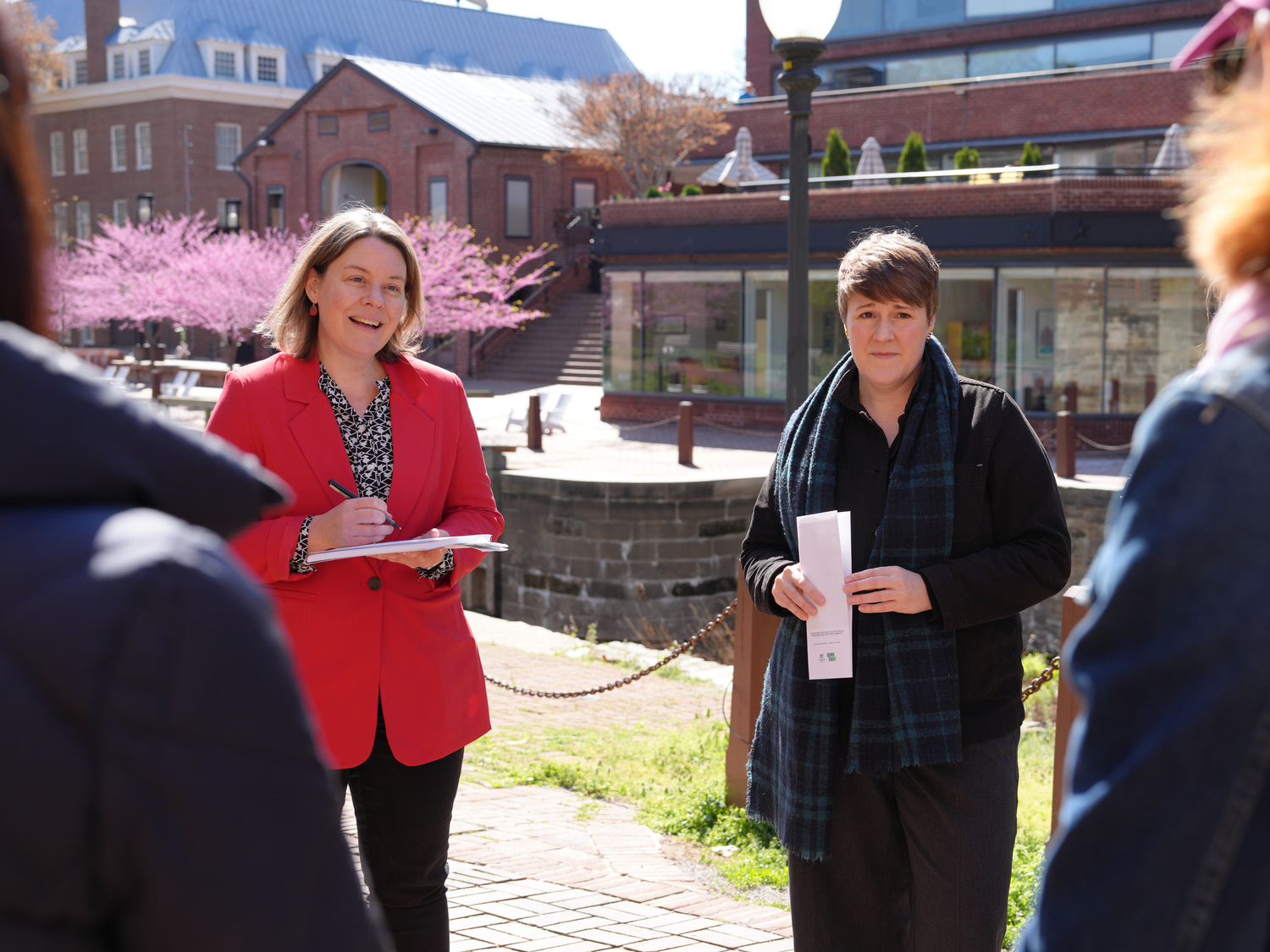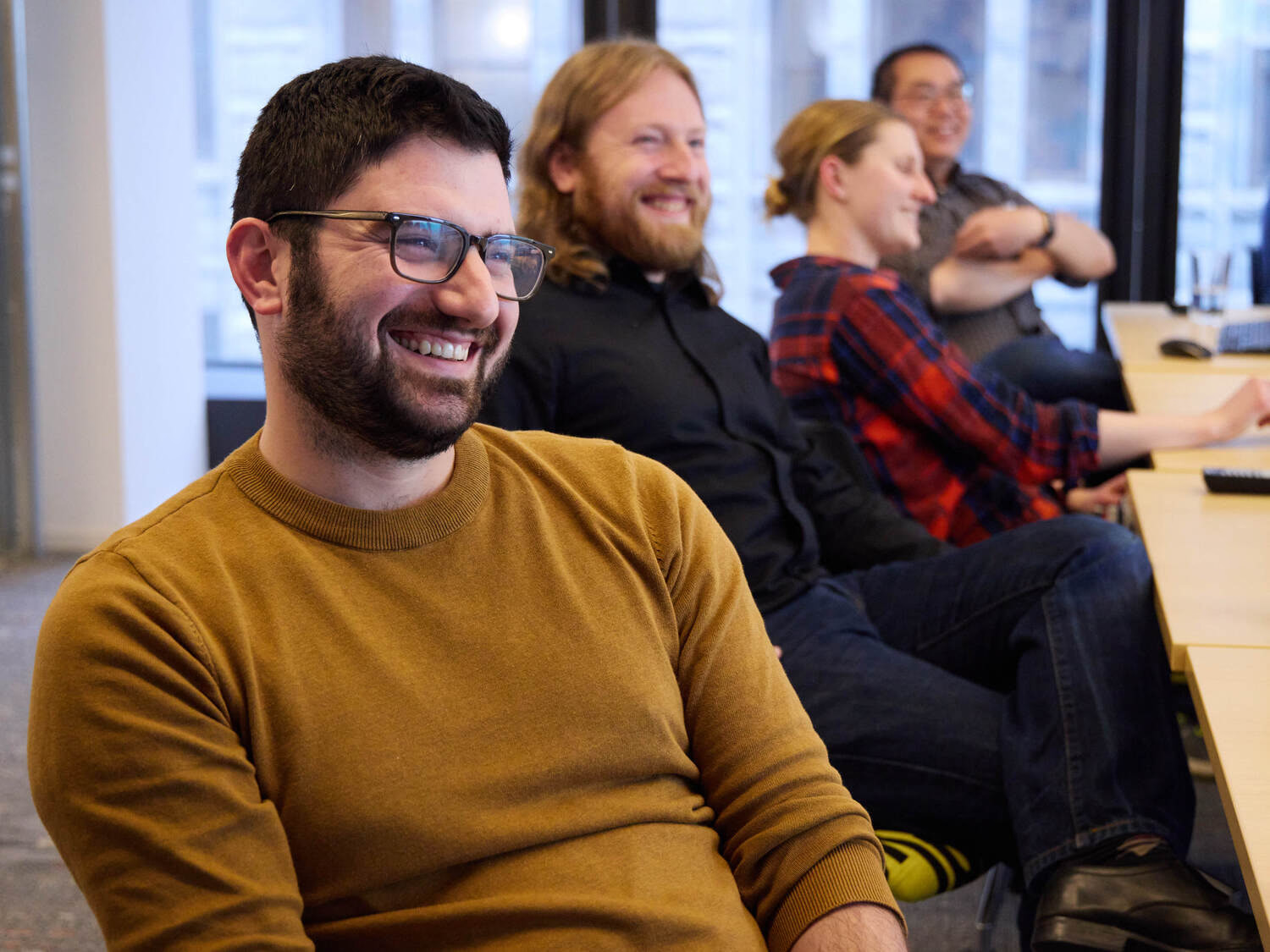The Peake Childhood Center’s innovative partnership model and thoughtfully designed new facility provide accessible, high-quality early childhood education—fostering lifelong success for children, supporting working families, and strengthening the Southeast community in Newport News.
Comprehensive early childhood care and education (ECCE) programs benefit everyone, and particularly low-income families. These programs allow parents to work outside the home, contribute to better outcomes for students, and generate significant economic gains for cities, states, and our country.
Unfortunately, the United States lags behind other nations in providing this essential service. While only 38% of three-year-olds and 67% of four-year-olds in the US are enrolled in early childhood services, the average enrollment across other OECD countries is 76% and 88% respectively.
The Peake Childhood Center’s new facility in Newport News, Virginia, exemplifies an innovative partnership model. By harnessing the collective resources of Peake’s nonprofit childcare and preschool program, Virginia Peninsula Community College’s early childhood development program, and the City of Newport News, this initiative highlights the power of collaboration in expanding opportunities to access high-quality early childhood education as well as workforce and community development.
Our design supports this forward-thinking program with state-of-the-art learning environments that nurture the whole child, promoting both academic and social development for children and providing a laboratory for adult students learning the art of teaching.
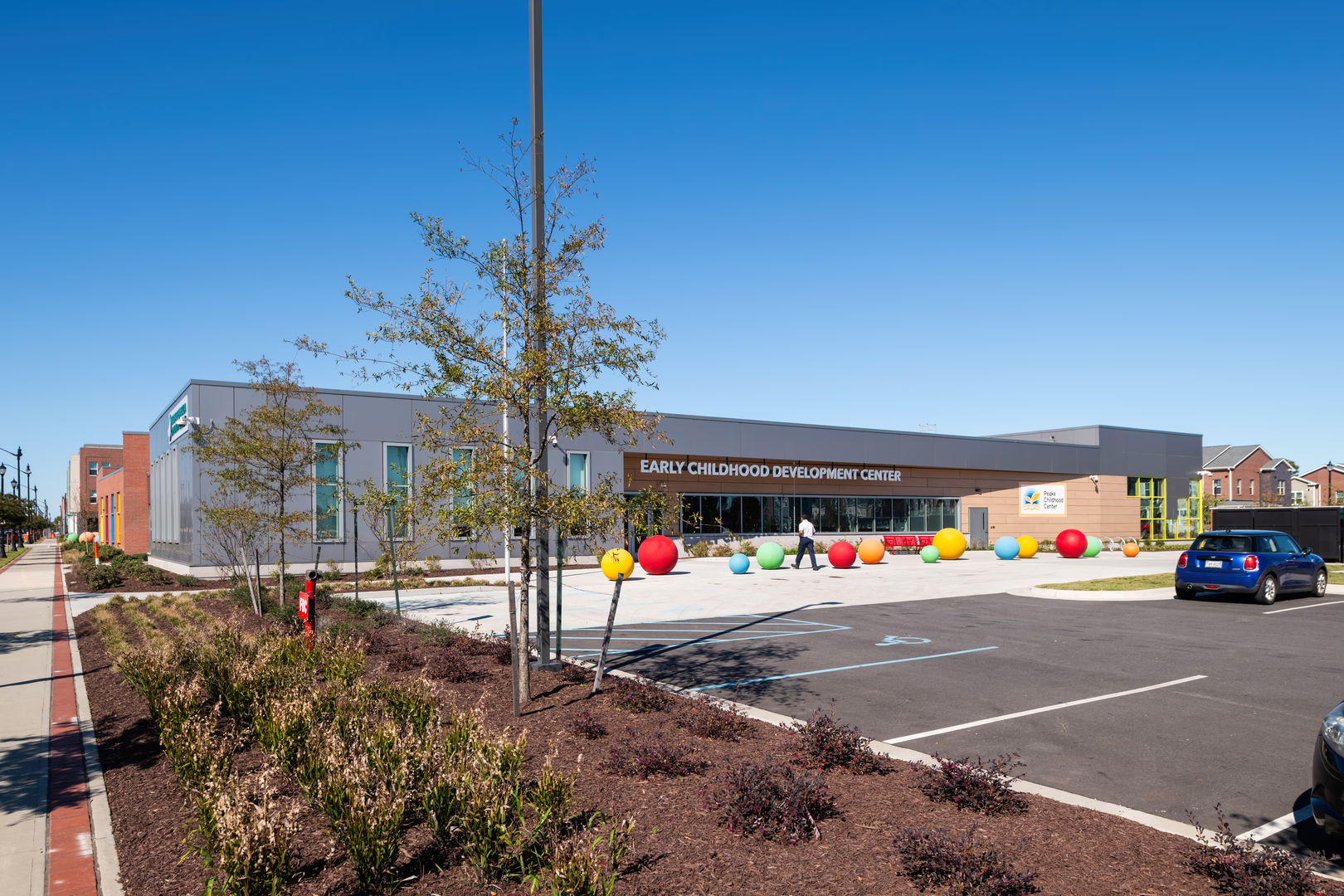
The Importance of Early Childhood Care and Education
ECCE plays a crucial role in preparing children for kindergarten and beyond. Since 90% of brain development occurs before the age of five, waiting until kindergarten to begin structured education and socialization is too late. Quality early childhood education fosters early literacy, math skills, social competence, and self-regulation. Additionally, it allows for the early detection of speech and language issues, enabling timely interventions that improve long-term outcomes.
The lifetime benefits of high-quality ECCE are well documented. Children who participate in these programs experience lower absenteeism, better math and reading skills, and are less likely to be retained in a grade or require special education services. They are also more likely to graduate high school, pursue higher education, and achieve higher lifetime wages. Furthermore, research suggests that quality early education reduces long-term health risks such as heart disease and elevated blood sugar.
ECCE also yields significant economic benefits for families and society. Affordable childcare enables parents to work, increasing household income and reducing poverty rates. On a broader scale, public investment in high-quality early childhood programs results in an estimated return of $4 to $12 for every dollar spent, as it reduces government costs associated with childhood poverty, special education services, and healthcare. Additionally, the increased earning potential of program graduates translates into higher tax revenues down the road.
Despite these advantages, access to high-quality ECCE remains a challenge due to the scarcity of public programs and high cost of private ones. The US Department of Labor found the annual cost of full-day center-based infant daycare in large metropolitan areas to be over $15,000, while full-day center-based preschool costs over $12,000. These expenses disproportionately affect low-income families, exacerbating educational achievement gaps and limiting social and economic mobility. Public investments in ECCE are crucial to breaking this cycle.

The New Peake Childhood Center
The new Peake Childhood Center in Newport News serves as a model for high-quality, accessible early childhood education. Peake’s second facility (its original location is in neighboring Hampton) can accommodate up to 200 children ranging from six weeks to four years old. With a dedicated staff of 37 professionals, the 32,500-sf facility offers a nurturing learning environment tailored to young children's developmental needs. Currently, 79% of the families Peake serves fall below the poverty line. Many receive state assistance for childcare; for others, Peake offers a sliding-scale tuition model based on family income and need.
The new Center is strategically located in Newport News' Marshall-Ridley community, a HUD Choice Neighborhood, where access to affordable, high-quality childcare has been limited. The City of Newport News is playing a key role in making this project possible by contributing construction funding and providing student meals and longitudinal data collection on student outcomes through the public school system. Additionally, Newport News Human Services will help with staffing by recruiting Marshall-Ridley residents, further embedding the center within the community.
Most notably, Peake is partnering with Virginia Peninsula Community College (VPCC) to establish a Center of Excellence in Early Childhood Learning and Development within the new Center. This collaboration embeds adult students in the facility for observation, internships, and student teaching, while also providing professional development opportunities for Peake teachers.

Design That Supports the Vision
The physical environment plays a critical role in early childhood education. In fact, it’s one of three key factors the Center for American Progress identifies as necessary to a quality ECCE program.
Our design for the new Peake Childhood Center is inspired by building blocks, symbolizing the foundation for early learning. The classroom “blocks” are intentionally arranged slightly askew to create movement along the rigid street grid. The multiple forms and material colors further refine the concept and provide a building scaled to the street and child. This dynamic pattern is symbolic of the endless ways block toys influence child development through emerging perceptual-motor skills and forming the foundation of STEM skills.
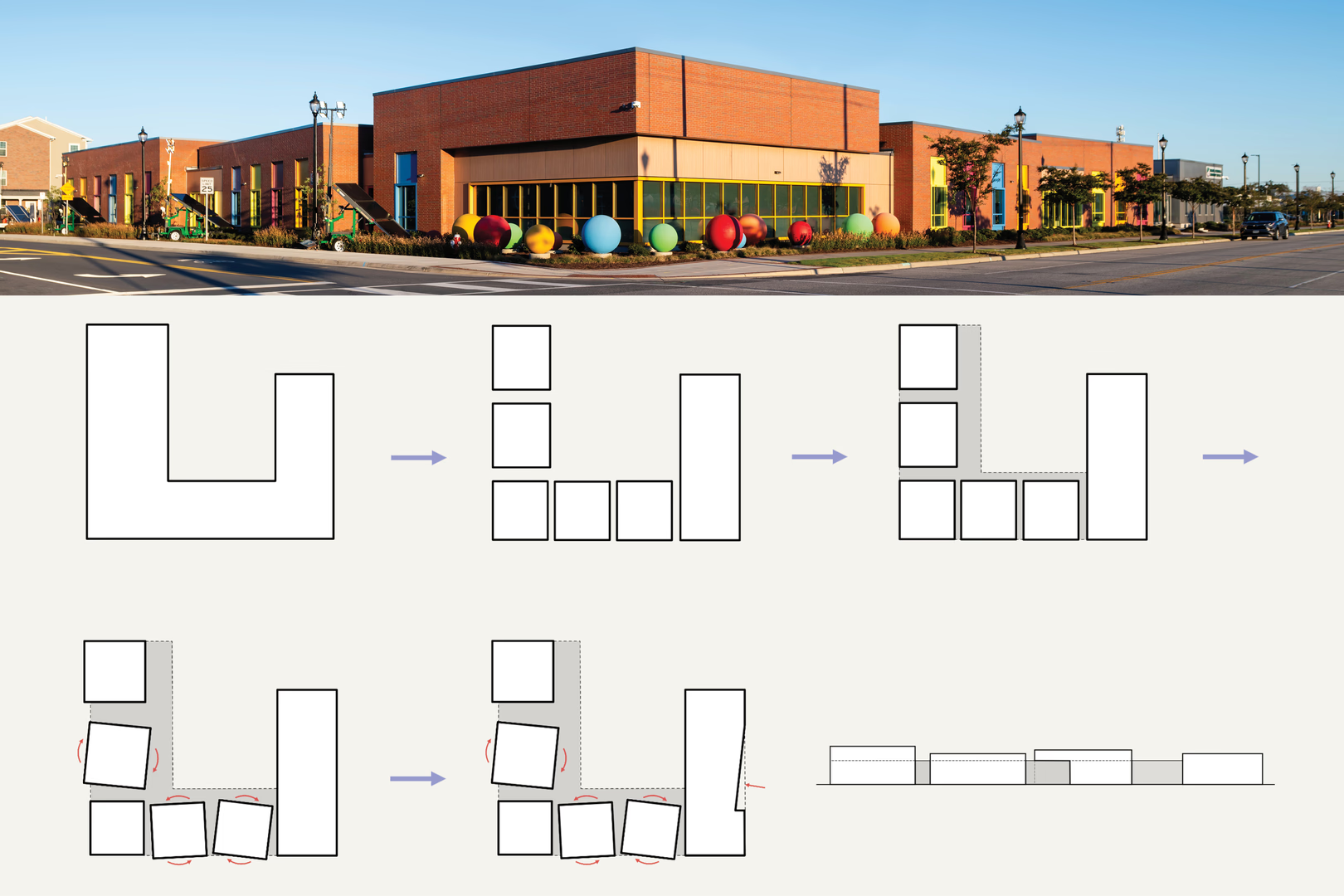
The following are primary elements of the design.
A WELCOMING ENTRY
The facility features a clear entry with an embedded vestibule that is both secure and inviting. Administrators have expansive views of the parking lot, building entry, and lobby. A family waiting area and parent meeting space just inside the entrance create a straightforward and comfortable experience for caregivers during drop-offs, pick-ups, and meetings with teachers.
ACTIVE LEARNING SPACES
We designed the classrooms with distinct areas for a variety of activities, including creative play, group work, focused reading, and “wet” activities like art projects. Advanced acoustical design allows for open environments while maintaining a conducive learning atmosphere.
BREAKOUT SPACES
Breakout spaces are informal, flexible areas that allow students a change of scenery from their home classrooms, which can stimulate creativity and different modes of learning. The Center incorporates a library with reading cubbies, a group activity zone, and a dedicated storytime corner, as well as a motor skills room.
NATURAL LIGHT AND VIEWS
Large windows frame views of the play courtyard and an adjacent green space. The natural light from these windows supports students’ circadian health, signaling to their bodies when it’s time to be awake and alert and when it’s time to begin winding down for the day.
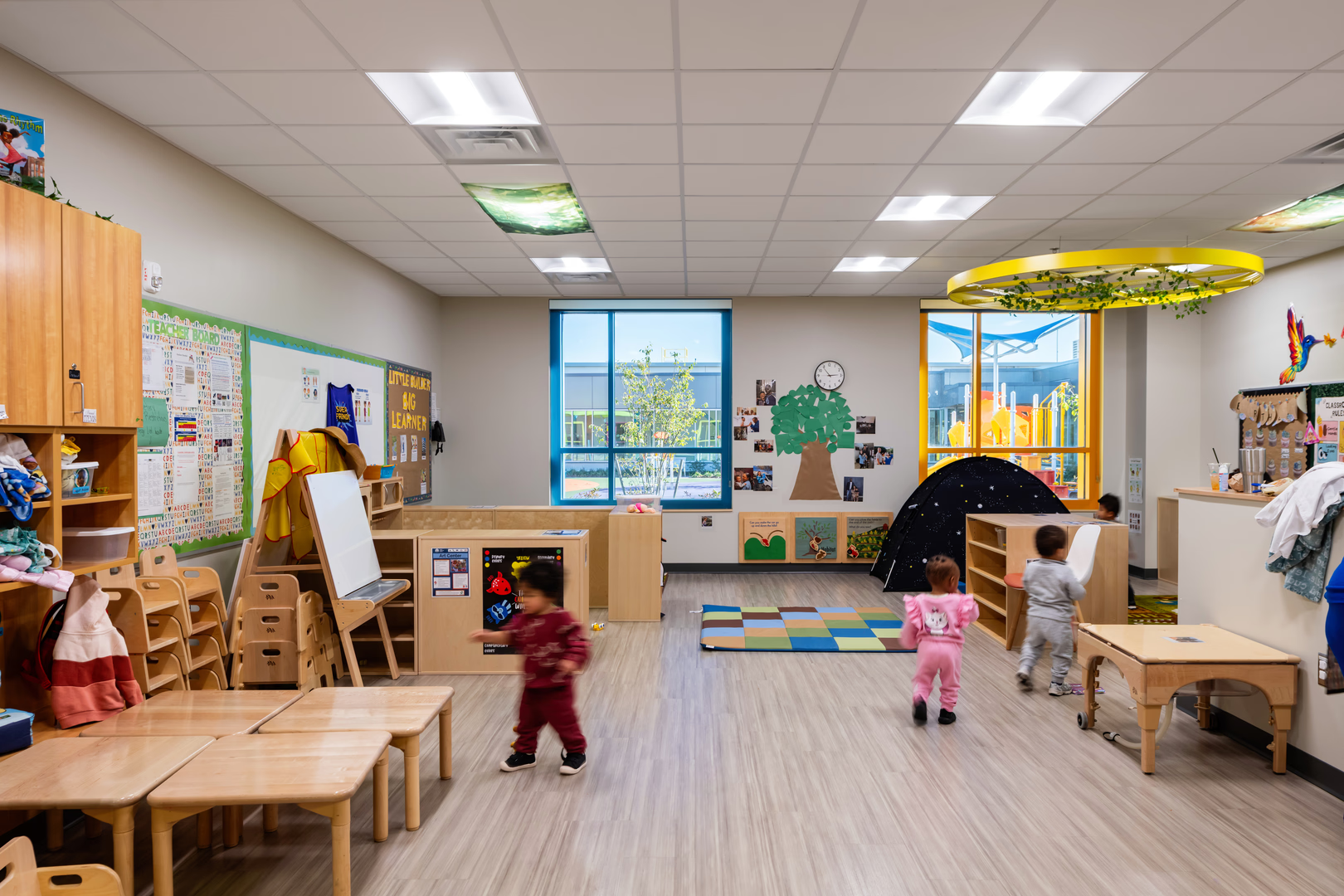
INDOOR/OUTDOOR CONNECTIONS
The building form encloses an outdoor learning and play courtyard with a variety of equipment that facilitates exercise and the development of fine motor skills. Large windows in the corridors, classrooms, and multipurpose room connect the interior/exterior activities and to the community beyond.
CHILD-SCALED DESIGN
Furniture and window heights are tailored to young children to support comfort, engagement, and the benefits of views to the outdoors.
INDOOR AIR QUALITY
Given the center’s proximity to an industrial area, enhanced air filtration and a geothermal system create clean, sustainable air circulation without additional carbon emissions.
A New Chapter
The new Peake Childhood Center exemplifies an innovative and holistic approach to ECCE, integrating high-quality instruction, economic accessibility, and thoughtful design. By prioritizing the needs of both children and families, this center represents a key investment in a historically underserved community.
Peake’s collaborative model can serve as a blueprint for other localities, proving that comprehensive early childhood care and education benefit not just the individuals it serves but society as a whole. Through intentional design and strategic partnerships, the Peake Childhood Center will nurture the next generation, laying the groundwork for lifelong success.





